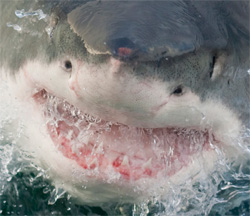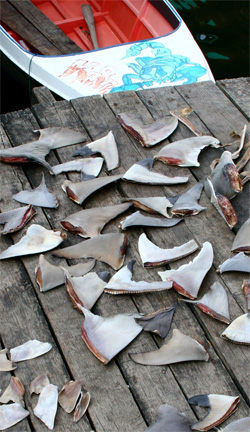
Chapter 14. Tracking Jaws
Tracking Jaws

Read the article below. Then answer the questions that follow.

In horror movies great white sharks lurk around sunny beaches, waiting to rip apart unsuspecting swimmers. In reality, white sharks almost always go about their business without paying much attention to swimmers. White sharks (Carcharodon carcharias) are rarely sighted, and humans aren’t their food type.
Humans pose a far greater threat to white sharks than vice versa. Despite an international ban, the trade of shark teeth and fins remains a big industry. Furthermore, because white sharks live long, are slow to mature and mate, and have small litter sizes, the elimination of a single individual can have a big population impact.
This is why marine biologists have been searching desperately for a sampling method to count white sharks. When scientists are concerned that a marine species may be threatened or endangered, they often do a population assesssment to determine whether or not better protection is needed. But this is easier said than done.
California white sharks keep a low profile

It turns out that California white sharks are especially evasive. Researches have not been able to get a good abundance estimate because there are far fewer white sharks in California’s waters than there are fish, marine mammals, and other sharks. White sharks always have been a rare sight in California, and because they don’t come to the surface to breathe like dolphins and whales, it is difficult to get a solid count, which is needed for a population estimate.
Despite these problems, University of California - Davis and Stanford University researchers completed the first rigorous census of its kind in May 2011. Armed with cameras, the researchers piloted small boats to white shark feeding locations in the Pacific Ocean and lured sharks into photo range using a seal-shaped decoy on a fishing line. As the triangular dorsal fins skimmed the surface of the water, researchers snapped photos—the very kinds of images we associate with Jaws!
By photographing the uniquely jagged edges of the dorsal fins, the researchers were able to distinguish between individual sharks. The fin photographs prevented mistakes like double-counting the same individual.
Taking multiple photos of the same shark also helped document site fidelity. In other words, if sharks keep coming back to the same coastal locations during their migration route, they likely are true members of the California population and not visitors from afar.
Mighty sharks in small numbers
In total the researchers identified 131 individual sharks. Population models estimate there are only about 220 adult and sub-adult white sharks in the Northeast Pacific Ocean. This is far fewer than expected.
“This is why taking even a single individual could have major implications,” says Taylor Chapple, a researcher at the University of California - Davis who led the study.
To put things in perspective, there are 25,000 polar bears (Ursus maritimus) estimated to exist today; the species has been classified as endangered.
Researchers don’t have enough information to estimate the total number of white sharks in the world’s oceans. Distinct populations of white sharks can be found in South Africa and Australia/New Zealand, and one recent count conduced in Spencer Gulf, Australia, found 191 white sharks. Yet due to the aforementioned complexities of conducting a survey, such population studies are rare.
Researchers also can’t estimate how dramatically populations have plummeted. While trophy hunting, pollution, and commercial fishing practices have contributed to declines, it may be that populations of white sharks have always been small. In either case, the shark’s small numbers make it vulnerable to human impacts. With so few breeding individuals, the survival of the species may depend on human protection.
© 2015 WH Freeman and Company.
14.1 Comprehension Questions
Answer the following questions to demonstrate your understanding of the article.
1.
True/False:
Movies like Jaws accurately depict white sharks’ taste for human flesh.
2.
To prevent multiple counts of the same shark, researchers took photos of white sharks’ ________ , because no two look exactly alike.
| A. |
| B. |
| C. |
| D. |
| E. |
3.
In the first-ever shark census, researchers counted a grand total of individual sharks off the coast of California. Population models estimate that there are adult/sub-adult white sharks in the Northeast Pacific Ocean.
4.
Losing just one white shark is of great concern for a number of reasons. What specific reasons are cited by the article? Check ALL that apply.
White sharks have small litter sizes.
White sharks mature slowly.
White sharks mate frequently.
White sharks eat their own young.
White sharks are slow to mate.
White sharks generally live long lives.
White sharks are often sterile.
5.
Fill in the blank to complete the sentence:
Locations where white sharks can be found include the California coast, Australia, New Zealand, and also .
6.
Which of the following steps could be taken to preserve white sharks from extinction? Select ALL that apply.
Better enforcement of restrictions on trade of shark teeth and fins.
Prohibit trophy hunting of sharks.
Restrict beach access to prevent interactions between sharks and humans.
Reduce pollution in the world’s oceans.
Restrict commercial fishing practices that frequently result in sharks being accidentally caught.
Promote the hunting of sharks’ natural predators to help sharks multiply.
7.
Which of the following is the most plausible reason why white shark numbers always may have been low?
| A. |
| B. |
| C. |
| D. |
| E. |
8.
Why has it been difficult to sample white sharks and determine their numbers? Select ALL that apply.
They frequently migrate to the Arctic to feed, making them difficult to track.
They don’t come to the surface to breathe like many other aquatic animals.
White sharks are nocturnal, which means all research must be conducted at night.
There are considerably fewer sharks in the oceans than other aquatic life.
Sharks are inherently evasive by nature.
Lack of funding for shark research has made tracking and counting sharks prohibitive.
9.
Male white sharks mature at approximately ten years of age, while female white sharks mature at fifteen years of age. Why would a slow maturity rate contribute to the slow recovery of a population if a few mature adults were lost?
| A. |
| B. |
| C. |
| D. |
| E. |
10.
Why can a white shark spend much of its life beneath the water without coming to the surface?
| A. |
| B. |
| C. |
| D. |
| E. |
Activity results are being submitted...